Dreaming of Childhood (6 May 2003)

Pulteney蒸留所の南側に出るとスコットランドらしい牧草地の中にぽつんと学校(Wick South Primary School)があった。側には小川があって蒸留所に流れ込んでいる。この小川をさかのぼると仕込み水の採取地である湖があるのだろうか。
童心に帰り、子供の頃のように川を上ろうかとも思ったがそれ程時間に余裕はない。
大人になって自由になるものは増えたけど、自由になる時間は確実に失っている。
Wick South Primary School is in the south of Pulteney Distillery and there was a burn, called “Mill Lode” next to the school. The burn flew into the distillery. The loch, which provide water for Pulteney Distillery, would lie on the upper stream.
I wanted to go up the burn, feeling like a child again. But I didn’t have enough a free time.
I think I’ve got something to make free, but I’ve lost my free time since I grew up a man
- カテゴリー別アーカイブ Northern Highland
-
-
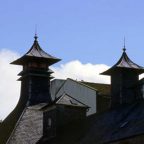 Muir of Ord(1)
Muir of Ord(1)
Glen Ord Distillery(10 May 2003)
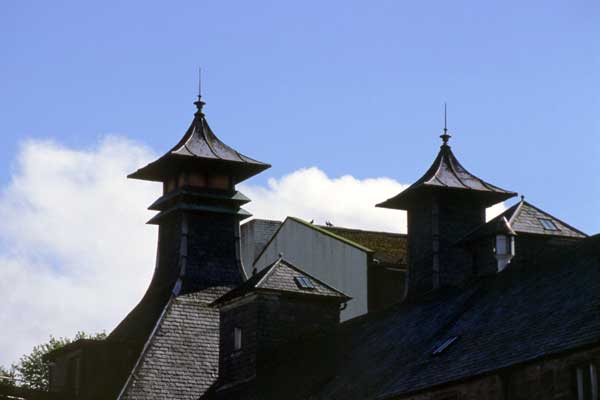
Glen Ord蒸留所は1838年に現在のMuir of Ordの町の北西に創設されたことになっているが、この地域はスコットランドの中で古くからウィスキー造りが盛んだった地域の一つ。Glen Ordのある場所ではそれ以前からウィスキー造りは行われており、法的に登録されたのが1838年ということらしい。
1878年に一度火事で全焼しているがすぐに建て直された。また、19世紀末にはロンドンのみならずシンガポールや南アフリカにモルトウィスキーが輸出されていたという記録がある。
1961年のサラディンモルティング導入まではフロアモルティングが行われており、現在は隣接するGlen Ord Maltingsで製麦が行われ、他の蒸留所にも供給されている。
Glen Ord Distillery was legally established at western side of Muir of Ord in 1838, however there were illicit distilleries there and making whisky had been started. Illicit whisky was really popular industry in this area.
Distillery burnt down in fire in 1878, and new buildings was build as soon. Glen Ord Whisky was sold in London and exported to South Africa and Singapore in the late of 19th.
Floor malting was finished because of introduction of saladin malting in 1961. Now, distillery use barley malt which made by Glen Ord Maltings next to the distillery.
-
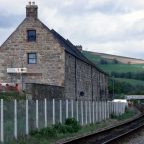 Dingwall(1)
Dingwall(1)
Ben Wyvis Distillery(10 May 2003)

スコットランドで最初のウィスキー蒸留所と言われる”Ferintosh”は正確な場所がわからない。でもDingwallの周辺であったことは確からしい。この地域はウィスキー造りが盛んで18世紀後半には数ヶ所の蒸留所があったと記録されている。
Ben Wyvis蒸留所は1879年にDingwallの南側にある小高い丘の斜面を利用して作られたこの地区唯一の近代的な蒸留所で当時としては最新の設備と生産能力を備えていた。更に熱の再利用設備やドラフやポットエールを近隣の農家が使用しやすいようにするなど生産設備以外の面でも進んでいた。2基のスティルを持ち、年間生産量は約70万リットルだった。
でも経営はうまくいかず、1922年にDCL(現在のUDV)が買収し、閉鎖された。その後名前だけは復活し、1965年にInvergordonのグレーン工場に造られたモルトウィスキー蒸留施設に”Ben Wyvis”と名付けられた。が、こちらも10年程の生命だった。
現在は鉄道の側にウェアハウスだった建物が残るのみ。丘の上に何か残っているかと期待して登ったが何も残っていなかった。
Ferintosh is known as the the first distillery in Scotland, but the location is not known for certain. It’s said that it would probably be near Dingwall. Making whisky was thriving around there. It is recorded that there were some distilleries there in the end of 18th.
Ben Wyvis Distillery was established at the steep site on the hill, south of Dingwall. It was the only major industrial distillery around there. It had modern equipments and productive capacity, and also had recycling heat system, providing system which was easy to buy draff and pot ale for farmers. There were 2 pot stills and annual output was about 700,000 liters.
However, operation was not good. Finally, DCL(present UDV) acquired the distillery, and then Ben Wyvis was closed in 1922. About 20 years later, the name “Ben Wyvis” was come back. The plant of making malt whisky was build inside Invergordon Grain Distillery and called “Ben Wyvis”. But similarly, it was closed about 10 years later.
Now, the building of warehouse are still standing beside a railway. Nothing remained on the hill.
-
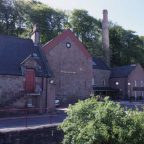 Inverness(1)
Inverness(1)
Millburn Distillery(11 May 2003)
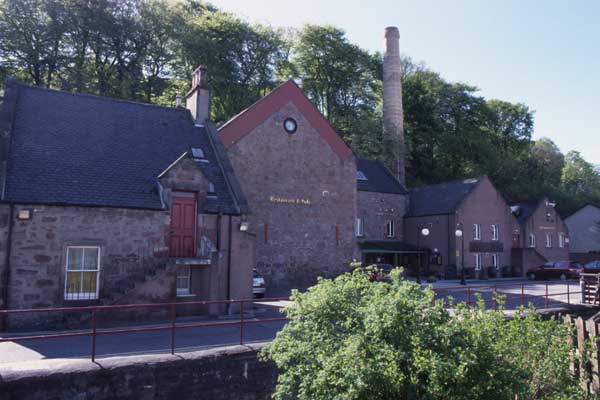
Invernessにはかつて3つの蒸留所(Glen Albyn, Glen Mhor, Millburn)があったが1980年代のウィスキー不況は乗り切れずすべて閉鎖されてしまった。
Millburn蒸留所は1807年創業のInvernessで最も古い蒸留所。でも19世紀末から20世紀初頭にかけて次々とオーナーが代わった。最終的に1937年にDCLが買収し、1985年の閉鎖まで操業していた。
Millburn蒸留所の建物はレストランとして利用されているがキルンもなく、蒸留所であったことに気づく人も少ない。敷地は狭く、拡張も出来ないことを考えるとUD社が閉鎖したのもわからなくもない。大きな町にある蒸留所が生き残るのは難しい。
There were 3 distilleies, Glen Albyn, Glen Mhor, and Millburn in Inverness. However, all of them couldn’t get over the difficulty of depression of whisky in 1980’s, and they were closed.
Millburn Distillery was established in 1807, it was the oldest distillery in Inverness. But some owners took over the distillery between the end of 19th and the first of 20th. Finally DCL took over in 1937 and had been operated until 1985, when the distillery was closed.
Some buildings are used as a restaurant. But malt kiln were demolished, so people wouldn’t know that it was distillery. It’s understandable that UDV closed Millburn Distillery, because it was on the small site and expansion was not possible. I think it’s really difficult to operate distilleries in a city.
-
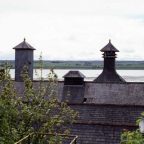 Alness(1)
Alness(1)
Dalmore Distillery(9 May 2003)
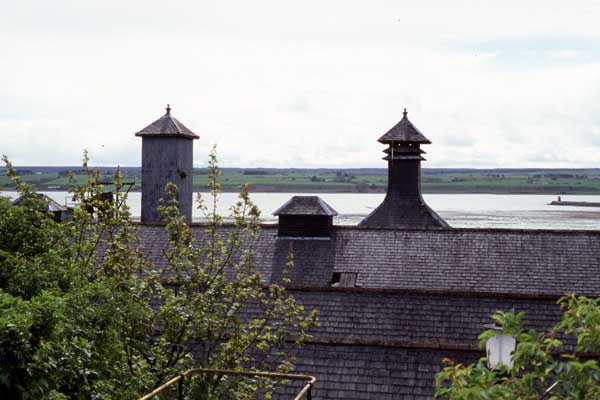
Cromarty Firthに面した海岸に建つDalmore蒸留所は1839年に創設された。1867年にMackenzie一族がオーナーとなり、1960年まで一族での経営がされていた。
第一次大戦中の1917年11月、蒸留所はアメリカ海軍によって接収された。Alness駅からの支線があり、港に近い、そしてウェアハウスが工場に適していたという不運が重なった。また当時の首相Lloyd Georgeが禁酒推進派で酒に対してよいイメージを持っていなかったことも影響しているのだろう。Sir Winston Churchillとはずいぶんと違う。
蒸留所のウェアハウスは、すべての樽を近隣の3蒸留所に移した後、機雷工場に改装された。1918年の終戦までに約32,000個の機雷がDalmoreの港から搬出されている。
1920年6月、蒸留所は1919年2月の機雷爆発事故により壊された部分はそのままで返還された。現在ならば当然賠償請求されるけど、その当時は軍への民間協力は当然だったのだろうか。唯一の救いは他の蒸留所に移送された樽が全く失われることなく戻ってきたことだろう。
Dalmore Distillery lies on the share look out on Cromarty Firth. It was established in 1839 and owned by Mackenzie’s family in 1867. They had operated Dalmore Distillery until 1960.
Dalmore Distillery was took over by American Navy in Novenber 1917, during the World War 1st. Because it had a branch line to Alness Station, near port, warehoses were fit to use as a plant. And I think that it was affected by Lloyd George, Prime Minister of UK at that time. He promoted temperance, he didn’t think that drinking was good for the government and community.
All caskes stored in warehouses were moved to closest three distilleries, and warehouses were converted into plants of mine. About 32,000 of mines had been shipped from pier of distillery until 1918, the end of the World War 1st.
Distillery was returned with warehouses which was broken by explosion of mine in Febrary, 1919. If it was the present time, they would be claimed damages, but they had to work together with military at that time. Fortunately, the casks which were moved other distilleries were came back perfectly.